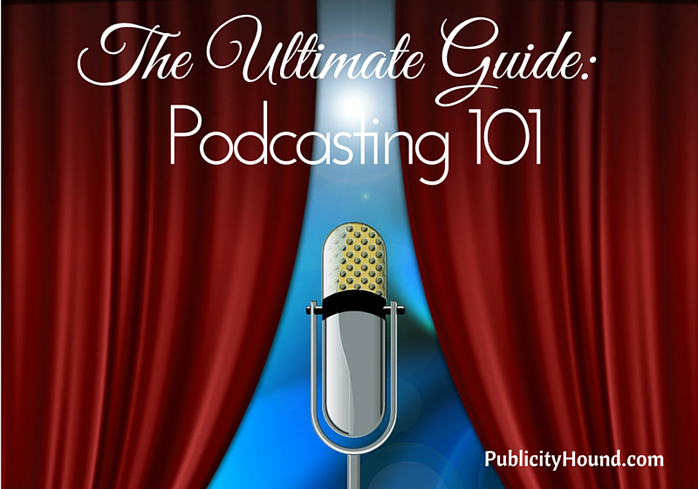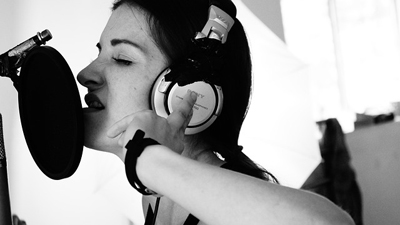

By Margaret Larkin
Now that you know what tools to use, where to buy them, how to use them, and mistakes to avoid, it’s time to record your podcast and publish it online.
Here are some basics about the process:
Do a trial run and test your sound. Make sure your equipment and software work before recording, and speak into your microphone to determine the best distance between your mouth and the mic.
You also should listen for any odd room sounds or hums. There’s a hum in this interview I did because my mic was too close to the computer, and I didn’t know about the grounding issue. My biggest mistake occurred when I didn’t test the sound for this interview. I only looked at the soundwave to confirm it was recording at the right levels (I made other technical mistakes with this interview that I can explain if you’re interested). Eyes aren’t enough—you need to use your ears, too!

Production
Audio production can be simple or complex, depending on the quality of your audio and how much editing and producing you want to do. To avoid trying to solve problems in post-production, which I tried to do many times because I was a podcasting newbie, make sure your recording is the best it can be. The only people who really know how to fix “bad” audio are audio engineers— and probably none of us have that level of expertise—so be careful!
You will probably need to edit your audio. It’s an art as well as a technical craft. If you don’t know how to edit audio, explore the tutorials at the Audacity website or refer to your software’s manual and website. Many helpful online videos demonstrate the editing process.
Here are three basic audio concepts to consider when producing your podcast:
Normalization — Sets the peak level of the audio; it sets the overall volume. It ensures that loud sounds will not be distorted.
Equalization (EQ) — Boosts or reduces various frequencies (high, mid, low). This is what people perceive as “treble” and “bass” when they hear something. You can read more about it here.
Compression — Balances the dynamic range of your audio (louder sounds become softer and quieter sounds become louder so that they’re better matched). Here’s a more detailed explanation of compression.
I think podcasters should do some type of compression or dynamic processing because when people listen with headphones, the levels will be uneven, and they’ll have to keep adjusting the volume because some people will sound too loud and others too soft.
Recording and editing is a trial-and-error process, and you can decide to go as deep as you want. As you develop your skills, the Internet will become your best friend. You’ll find many tutorials online about various aspects of audio, and advice for effective microphone techniques, so have fun exploring and learning lots of new things! The Media College website is worth checking out.
Music
It’s a good idea to have a short musical intro and outro for your podcast. Listen to what successful podcasters do with music, but make sure you have permission from the artist to use it. That’s what I did. Or use copyright-free music.
Once you choose your music or create your own, you’ll have to do a bit of multitrack mixing in your audio software. If you’re using Audacity, they explain the process of using narration with background music.
Mixing/Mix down/Export
Every software program has its own way of mixing down tracks into a single file, so follow the program’s directions. When your file is ready for export, you’ll have to make sure it’s an mp3 file to post online.
I recommend making your file mono, with a bitrate of 96 Kbps. You can do what you want–some people prefer to make all their audio stereo and use a bitrate of 128 Kbps. A standard sample rate is 44 kHz (though some people use 48 kHz). Whatever you choose, remember that it will affect the file size. After you mix down your file, try variations to determine what sounds the best to you.
Art
If you want to submit your podcast to iTunes and other podcast directories, you’ll need cover art. It will also show up in people’s audio libraries when you create ID3 tags. Each podcast directory has size specifications, so conform your art to those dimensions. Of course, your art will also represent your podcast wherever you promote it, so it’s best to have a designer create it.
ID3 Tags
When you load music on your playlist in iTunes, Windows, or other digital audio systems, you’ll notice details about the song, artist, year, etc., and you’ll probably see an image as well. That information comes from ID3 tags, and they are essential for each of your podcast episodes. Decide on a consistent naming convention and tag each episode so that your podcast has uniformity and will be easy to locate in a person’s audio collection.
Here’s a list of some common tags. Here’s an image of what the dialog box looks like in iTunes. To open it, click “Info.” If you have a PC, you can create the tags, also referred to as “metadata,” in the Windows Media Player.
Audacity has a window that automatically pops up when you mix down/export your project, and you’ll see empty spaces where you’ll type the various tags. You can also get ID3 tag software online, but you might not need it if you want to keep your tags simple or stick to what’s available in your own program or computer.
I create my ID3 tags in iTunes. This is what they look like:
Note that I use my website and contact information in some of the tags so people can find me. After you upload your art, your tags are complete.
Posting Your Podcast Online
Once you’ve finished producing your podcast, you must decide where you want to post it and how you want to share it. My advice: Put all your audio on your own website.
I know people who use podcast services such as Libsyn, an established and popular service, Blubrry, Podbean, Podomatic, Amazon S3 or audio sites such as Sound Cloud . The advantage of a hosting service is that it makes sharing your podcast on the Web easy. Storage is already set up, and they’ll create an RSS feed for you. That’s how you “syndicate” your podcast. RSS feeds aren’t as widely used by people as they used to be, but if you want to know more about them, read this Wikipedia article on RSS feeds.
However, if you want control over your audio and avoid spending a lot of money (the podcasting services charge for increasing hits, storage, etc.), then you should host your own audio at your website.
Here’s what I did.
When I started my podcast, I decided to upload my audio files to my website, hold them in a folder, and use the web address of the audio file wherever I wanted it. I used Blogger to share my files and write the description. Originally I used an HTML code to create a player, but the Web standards changed, so I ended up simply posting an audio link in each Blogger post, which opens when people click on it. They can download it, too.
I like having the freedom and control, and it doesn’t matter how big my audio file is, or how many hits I have. I essentially have unlimited storage space, and the amount of downloads and hits don’t affect what I pay to my website host, either. I used Feedburner to create an RSS and to send my feed to iTunes and do other things, but Google seems to be phasing out Feedburner. So I wouldn’t recommend that.
Here’s what I recommend. Use WordPress to build your site, and use plugins to create your podcast. I’m not talking about getting a blog at WordPress.com, but getting your own domain name and building it yourself or hiring a techie to do it for you. Many of the WordPress templates are easy to use.
A popular option is Weaver. By having your own website with your own content, you will have control of your brand, and you can centralize your blog, podcast and whatever else you want there (like what The Publicity Hound site does). It’s your property!
Also, WordPress has a built-in RSS feature, so you don’t have to worry about creating one. RSS feed creation is very technical—here’s an explanation and example of how to build one by hand.
WordPress comes with feeds, and accommodates podcasting. You can check out the WordPress plugins Seriously Simple Podcasting and Powerpress. There are others, too, but make sure they have good reviews and many downloads.
If you already have your own website, you could also use the Podcast Generator to add to your site.
Thanks to Joan for letting me share some of my knowledge with you! I’ve tried to cover the basics of podcasting here. If you have any questions, feel free to ask in the Comments below.